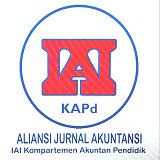MATERIAL FLOW COST ACCOUNTING SEBAGAI UPAYA EFISIENSI BIAYA PRODUKSI KERUPUK IKAN ERNA JAYA
Abstract
The purpose of this research is to analyze whether the fish crackers in every production process Erna Jaya has generated material losses, in order to obtain transparent information on the effectiveness and efficiency of the use of raw materials and energy in the overall production process. Based on analysis of this study, it is suggested that the fish cracker factory Erna Jaya had material losses/waste in the production process by 15% derived from raw materials and energy is wasted. The results of this study provide a solution to improve production processes and recycle the waste generated as a production cost efficiency effort. As the ingredients and the dough is wasted and stuck to the production machine can be reused in the next production, a change of cooking oil on a regular basis, maintenance and engine maintenance by production personnel after each use, and can be sold as a raw material by a third party to increase income for the company.
Keywords: raw material, energy, material losses, Material Flow Cost Accounting, production costs
Full Text:
PDFReferences
Afifah, D. Novita, N. (2021). Pencapaian Target Sustainable Development Goals dengan Konsep Material Flow Cost Accounting. Afifah | MAKSIMUM: Media Akuntansi Universitas Muhammadiyah Semarang. https://doi.org/10.26714/mki.11.1.2021.27-42
Chairunnisa, A. 2016. Perancangan Material Flow Cost Accounting (MFCA) dalam Upaya Efisiensi Penggunaan Bahan Baku dan Energi. Jakarta.
Febrina, F., & Rachmawati, N. A. (2023). Diversity of Book-Tax Conformity in Asean 4: Philippines, Indonesia, Malaysia, and Singapore. Jurnal Akuntansi dan Bisnis, 23(1).
Fitria, S. M., & Novita, N. (2020). Six Sigma Sebagai Strategi Bisnis Dalam Upaya Peningkatan Kualitas Produk. Jati: Jurnal Akuntansi Terapan Indonesia, 3(1), 1- 14. https://doi.org/10.18196/jati.030121
Fuadah & Arisman. 2013. "Adopting Environmental Management Accounting (EMA) in Indonesia". Forum Bisnis dan Kewirausahaan Jurnal Ilmiah STIE MDP. Jakarta.
Kementerian Koperasi dan UKM, 2013, Perkembangan Data Usaha Mikro, Kecil, Menengah (UMKM) dan Usaha Besar (UB), dilihat 26 Januari 2017,
Lastiati, A., Siregar, S. V., & Diyanty, V. (2020). Tax Avoidance and Cost of Debt: Ownership Structure and Corporate Governance. Pertanika Journal of Social Sciences & Humanities, 28(1).
Marota, et al., 2015, "Perancangan Penerapan Material Flow Cost Accounting untuk Peningkatan Keberlanjutan Perusahaan PT. XYZ", Jurnal Manajemen & Agribisnis. Bogor.
Ministry of Economy, Trade and Industry (METI). 2010. Material Flow Cost Accounting MFCA Case Examples. Japan.
Purnomo, A. 2014. "Penerapan Environmental Management Accounting dalam Upaya Meningkatkan Kinerja UD Z di Sidoarjo". Jurnal Ilmiah Mahasiswa Universitas Surabaya. Surabaya.
Rachmawati, N. A., & Martani, D. (2014). Pengaruh large positive abnormal book-tax differences terhadap persistensi laba. Jurnal Akuntansi dan Keuangan Indonesia, 11(2), 1.
Rachmawati, N. A., & Martani, D. (2017). Book-tax conformity level on the relationship between tax reporting aggressiveness and financial reporting aggressiveness. Australasian Accounting, Business and Finance Journal, 11(4), 86-101.
Rachmawati, N. A., Gani, L., & Rossieta, H. (2017). Loyalitas nasabah dan kinerja perBankan di indonesia. Jurnal Keuangan dan Perbankan, 21(1), 144-156.
Rachmawati, N. A., Ramayanti, R., & Setiawan, R. (2021). Tingkat Kesadaran dan Kesiapan Pelaku Umkm Dalam Menyusun Laporan Keuangan dan Pajak. Jurnal Akuntansi dan Bisnis, 21(2).
Rachmawati, N. A., Utama, S., & Siregar, S. V. N. P. (2020a). Persistensi Laba Antar Level Kompetisi Industri: Studi Empiris pada Perusahaan Amerika Serikat. Jurnal Akuntansi dan Bisnis, 20(1), 1-16.
Rachmawati, N. A., Utama, S., Martani, D., & Wardhani, R. (2019). Determinants of the complementary level of financial and tax aggressiveness: a cross-country study. International Journal of Managerial and Financial Accounting, 11(2), 145-166.
Rachmawati, N. A., Utama, S., Martani, D., & Wardhani, R. (2020b). Do country characteristics affect the complementary level of financial and tax aggressiveness?. Asian Academy of Management Journal of Accounting & Finance, 16(1).
Rachmawati, N. A., Utama, S., Martani, D., & Wardhani, R. (2023). Complementary level of financial and tax aggressiveness and the impact on cost of debt: A cross-country study. South African Journal of Accounting Research, 37(3), 161-176.
Ramayanti, R., Rachmawati, N. A., Azhar, Z., & Azman, N. H. N. (2023). Exploring intention and actual use in digital payments: A systematic review and roadmap for future research. Computers in Human Behavior Reports, 100348.
Sahri, N. A., & Novita. (2019). Kaizen Costing Sebagai Perbaikan Berkelanjutan Untuk Meningkatkan Keunggulan Bersaing Pada E-Commerce. Jurnal Kajian Akuntansi, 3(1), 18–43.
Schmidt and Nakajima, 2013, "Material Flow Cost Accounting as an Approach to Improve Resource Efficiency in Manufacturing Companies". Resources Journal. Switzerland.
Soraya, L. R., & Rachmawati, N. A. (2021). Determinats Of The Amount Of Related Party Transaction: Tax Expense And Institutional Ownership. Jurnal Reviu Akuntansi Dan Keuangan, 11(1), 30-39.
Syarif, A. M., & Novita, N. (2019). Environmental Management Accounting with Material Flow Cost Accounting: Strategy of Environmental Management in Small and Medium-sized Enterprises Production Activities. Indonesian Management & Accounting Research, 17(2), 143-167. https://doi.org/10.25105/imar.v17i2.5313
Tachikawa, H 2014, Manual on Material Flow Cost Accounting: ISO 14051, Asian Productivity Organization (APO), Japan.
Wahyuni, R. S., & Novita, N. (2021). COSO ERM Framework as the Basis of Strategic Planning in Islamic Banking. Jurnal Keuangan dan Perbankan, 25(1), 21-35.
Zamzami, M., & Novita, N. (2021). Apakah Gemba Kaizen Mampu Meningkatkan Kinerja Nonkeuangan Perguruan Tinggi?. Jurnal Akuntansi Multiparadigma, 12(1), 207-220.
DOI: https://doi.org/10.31326/tabr.v5i1.1979
Refbacks
- There are currently no refbacks.
View My Stats










